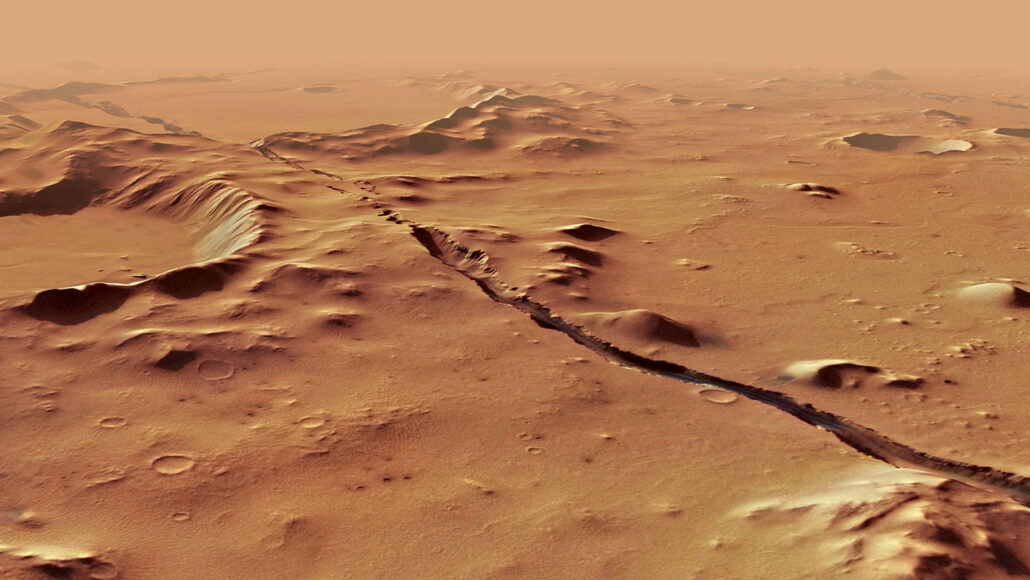Mars might still be volcanically active, quakes there suggest
Molten rock could be moving deep below the Red Planet's surface

A fracture cuts through Martian hills and craters in this image taken by the Mars Express orbiter.
ESA, DLR, FU Berlin (CC BY-SA 3.0 IGO)
Share this:
- Share via email (Opens in new window) Email
- Click to share on Facebook (Opens in new window) Facebook
- Click to share on X (Opens in new window) X
- Click to share on Pinterest (Opens in new window) Pinterest
- Click to share on Reddit (Opens in new window) Reddit
- Share to Google Classroom (Opens in new window) Google Classroom
- Click to print (Opens in new window) Print
Mars is rumbling.
Researchers have detected many recent Marsquakes on the Red Planet. Those shakes likely trace magma moving deep under the Martian surface. If true, the scientists say, Mars is still volcanically active. They describe their findings October 27 in Nature Astronomy.
Since touching down on Mars four years ago, NASA’s InSight lander has detected more than 1,000 Marsquakes. One of its tools records seismic waves. Those waves reveal information about a tremor’s size and location.
Earlier this year, scientists showed that several Marsquakes originated from a particular part of Mars. It’s known as Cerberus Fossae. Riddled with faults, it’s more than 1,000 kilometers (about 600 miles) from the InSight lander.
Those quakes were a type pretty familiar to quake specialists, notes Anna Mittelholz. She’s a planetary scientist at Harvard University in Cambridge, Mass. Their low-frequency waves “look much more like what we see for an earthquake,” she says.
Mittelholz was part of a team that has now analyzed many more Marsquakes. These include more than 1,000 high-frequency tremors — a less familiar type. Their signals are fairly weak. To home in on their origins, her team added the signals together. These quakes, too, seemed to come from the direction of Cerberus Fossae.
That was an impressive project, says Hrvoje Tkalčić: “No study before this one attempted to locate the high-frequency quakes.” Tkalčić is a geophysicist at the Australian National University in Canberra. He had no role in the new analysis.
Scientists were surprised to find that different types of quakes all came from the same region on Mars. Previous research had suggested Marsquakes might be caused by the slow cooling and shrinking of the planet’s surface. That process, which also occurs on the moon, should produce quakes spread evenly across the planet. As such, Mittelholz says, “The expectation was that Marsquakes would originate from all over the place.”
Her team also compared the seismic waves that InSight measured with those produced on Earth. Marsquakes looked like earthquakes that came from volcanic regions, the researchers found. That means Mars’ shakes are probably produced by magma flowing tens of kilometers below the planet’s surface.
Rather than being a geologically dead planet, as some have suggested, Mars might be surprisingly active, the researchers conclude. There’s still so much more to learn about Mars, says Mittelholz. “We’re only scratching the surface.”







